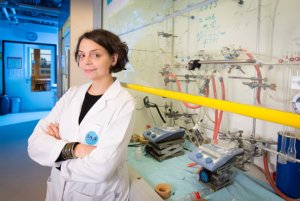Deformable materials
Soft Materials comprises a wide variety of states that are easily deformable, including fluids, polymers, colloids, and gels. This gives Soft Matter peculiar properties, such as various types of responsive behaviours and the ability to self-assemble into complex structures. Within MESA+ many groups research Soft Matter fundamentals or utilize these materials as a basis for their approaches to nanotechnology.
Research on the synthesis, material properties and applications of Soft Materials has a long and successful history at the University of Twente (UT). The research is broad and encompasses many length scales, ranging from the design of monomers and polymers with new and unique functionalities, the study of nano-scale drug delivery devices, the production of novel high-performance materials and the application of soft materials as tissue scaffolds, membranes and car tires. Connections to the industry are especially strong within these fields and there are cooperations with many large and small companies that produce and apply soft and advanced materials. Moreover, research on these materials within the UT has led to a substantial amount of successful start-up companies.
Infrastructure and ecosystem
Valorization has always been a strength of the UT, and hence there are very strong ties between research groups that work on Soft Materials and national and international companies. This involves major companies such as Dow, BASF, Sabic, Teijin, Pentair X-Flow, Apollo-Vredestein, ten Cate, DSM and Shell, alongside many smaller companies. Moreover, the UT is an entrepreneurial university, with research on polymers and soft matter leading in recent years to a variety of successful spin-off companies such as Artecs, NX Filtration, Hy2care, 20MED therapeutics, Nanomi and Lipocoat. There are many connections to all other universities in the Netherlands, especially to the other members of the 4TU federation.
Past&present performance
Nature publication: Conversion of light into macroscopic helical motion
 A key goal of nanotechnology is the development of artificial machines capable of converting molecular movement into macroscopic work. Here, researcher Nathalie Katsonis and others describe the design, synthesis and operation of spring-like materials capable of converting light energy into mechanical work at the macroscopic scale.
A key goal of nanotechnology is the development of artificial machines capable of converting molecular movement into macroscopic work. Here, researcher Nathalie Katsonis and others describe the design, synthesis and operation of spring-like materials capable of converting light energy into mechanical work at the macroscopic scale.
